Foods 2030 Lessons
| Site: | Joans-place |
| Course: | Foods |
| Book: | Foods 2030 Lessons |
| Printed by: | Guest user |
| Date: | Wednesday, 15 October 2025, 6:22 PM |
Description
Your Lessons
How to do this Module
Everything you need to hand in for this lesson is included in this check list. Each of the lessons will teach a portion of what you need to complete items on the check list. Please hand in the checklist and all the photos once you have completed the module.
Foods 2030: Food Decisions & Health Check list
Checklist for Module Completion
In this Module you need to learn how to balance the energy equation by using strategies for food intake analysis and preparing appropriate foods that help fuel the body efficiently and effectively.
Check off each of the following when you have done them.
Here is a link to the Checklist in Word format
Here is a link to upload your completed work
| I have completed the energy output assignment and submitted it for marking. | |
| I have completed the energy balance – intake vs output assignment and submitted it for marking. | |
| I washed my hands before working with food and have included a photo. | |
| I made sure my workspace was clean before I started and have included a photo. | |
| I have gathered the kitchen utensils, tools and ingredients needed for the recipe, before beginning and have included a photo. | |
| I have prepared a homemade snack and compare the nutritional values to a comparable commercial snack; e.g., granola, granola bar, cookies, muffins or beverage & submitted photos | |
| I have planned, prepared and evaluated a healthy balanced meal to assist with the achievement of growth and development during teen years & submitted photos | |
| I have planned, prepared and evaluated a healthy balanced meal to assist with the achievement of a healthy body weight& submitted photos | |
| I have ensured my workspace was clean after my cooking was complete and have included a photo. | |
|
I have had two people,(friends or family) test one of my cooking assignments. I have included their comments regarding the following questions: 1. Is the appearance of the food appetizing? 2. Does the food taste good? 3. Is there a suggestion for improvement? |
Body image
BODY IMAGE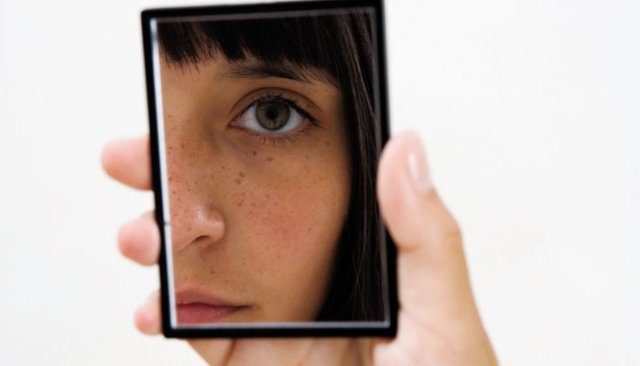
Your mental picture of yourself is your body image. It is related to your feelings and attitude about your physical appearance and your perception of how others see you. How you see yourself is directly related to your self esteem and therefore motivation and success.
You are bombarded daily with information about your physical appearance: from friends, relatives, parents, teachers, magazines, TV and newspapers. Sorting out what is the truth is an important step in developing and keeping a positive body image. Fashion magazines, newspapers, television and Hollywood bombard us with images that tell us that women should be thin and men should be muscular. These idols are portrayed as being beautiful, successful, in control and accepted. The result of this promotion is an increasing desire to be too thin especially among adolescent females.
For females, the search for low calorie, low fat diet foods becomes a major consideration in selecting food. For those into body building and shaping, foods and supplements advertised to increase muscle mass are pursued. The powerful desire to shape your body can result in physically and psychologically debilitating eating disorders such as anorexia (fasting and reduced food consumption) and bulimia (overeating followed by depression, then vomiting and/or excessive exercise and/or laxative abuse).
Some recent statistics:
- 30-60% of adolescents are dissatisfied with their weight or body shape
- 60% of Canadian children do not meet average cardiovascular fitness standards
- 7-17 year olds are the heaviest users of diet pills in the United States
- Half of normal weight girls are dieting because they think they are overweight
- 7% of high school males and 3% of females take steroids to increase their muscle mass
- 40% of males aged 12-22 are dissatisfied with their weight.
There is no “ideal weight” for everyone of the same height and age because people have different body compositions. Instead there is a range of weights that are healthy for each height. Even these tables don’t take into consideration the differences in amount of muscle and fat in each individual’s body. Use the tables only as guidelines to assess your current weight. Remember there are dangers to being underweight as well as overfat. Healthy eating, regular physical activity and self acceptance are important factors in developing a positive body image.
BODY COMPOSITION
Your body is composed mainly of fat, muscle, water and minerals. Daily fluctuations in body weight occur mainly due to changes in the water content of your body. Over a period of a week, body weight usually remains constant unless there are major changes in your food consumption (energy intake) or physical activity (energy output).
Body composition is dependent on the following factors:
- Frame size - the weight and size of your bone structure.
- Gender - female bodies have proportionally more fat than male bodies.
- Age - during growth to adulthood, the total water composition of your body decreases and the fat composition increases. Even if the same weight is maintained throughout your adult like, active tissue is progressively replaced by fat tissue. In other words, even if our body weight does not change, we become increasingly fatter as we grow older.
Physical Activity - physical activity results in more muscle, lack of physical activity results in more fat.
Body weight is related to body composition:
- A larger frame holds more muscle tissue and therefore weighs more
- A sedentary person may be within his/her weight range, but overfat
- A person doing heavy physical work most hours of the day may be overweight according to the height/weight charts, but not fat.
- Active individuals have a greater muscle mass than do inactive people and may weight more because muscle tissue is heavier than fat tissue.
- Training athletes and weight lifters may contain very little fat tissue, but may be overweight when plotted on the height/weight charts.
- As your weight increases over time, you gain fat and/or muscle tissue depending on your physical activity, i.e. weight lifters and athletes gain weight mostly in the form of muscle; sedentary individuals gain fat tissue.
- As your weight decreases over time you lose fat and/or muscle tissue depending on your physical activity
We can change our body composition through physical activity. In general, increasing your physical activity increases the proportion of muscle to fat tissue you have in your body
Goals for achieving and maintaining healthy body composition.
The key to maintaining a healthy body composition is to consume a balanced diet, drink plenty of fluids and participate in daily activity.
UNDERWEIGHT
Extremes in underweight can shorten an individual’s life span. A person who is more than 10% below the normal weight is considered to be underweight. Twenty percent or more below normal weight is cause for concern because serious results may occur, especially in younger people.
Health Risks of being Underweight
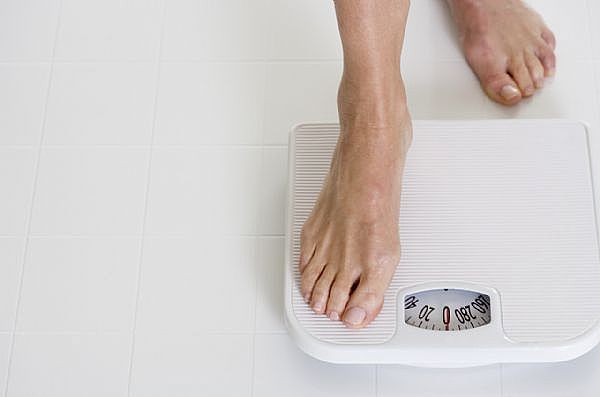
- heart irregularities
- lowered resistance to infection
- nutrition deficiencies
- chronic fatigue
- anemia
- eating disorders
- diarrhea
- depression
- distorted body image
Some of the causes of underweight are:
- Disease
- Diminished food intake from psychological, anorexia or economic reasons
- Greatly increase activity
- Irregular and inadequate meals
Treatment
Provide a sufficiently high caloric intake to gain weight and establish good food habits. Unless good food habits are formed, a person will slip back into the former way of eating and the problem will repeat itself.
- Gradual increase in calories: Attractive, nutritionally adequate diet with snacks
- Moderate exercise to stimulate the appetite, maintain general health, and improve muscle tone.
- Moral support with short and long-term goals.
OVERFAT
Overfat is one of the most common medical problems today. Obesity is an abnormal condition due to excessive deposits of fat in the body. The cause of overfat in most cases is simply eating too much. Being overfat places an added burden on the heart, circulatory system, liver and gall bladder. It also increases the risk in surgery. Most overfat people have trouble with their feet. The bones of the feet were meant to carry only a certain amount of weight. Imagine carrying a 50 lb back pack around and how good it would feel to take it off at the end of the day.
Treatment
Change your lifestyle - Increase physical activity and provide a diet lower in calories, but nutritionally balanced to lose weight and establish good food habits. Unless good food habits are formed, a person will slip back into the former way of eating and the problem will repeat itself.
- Gradual decrease in calories: fewer servings, decrease in fat content and increase in fibre
- Increase in physical activity to further create a deficit in calories.
- Moral support with short and long-term goals.
Healthy Eating
ENERGY INTAKE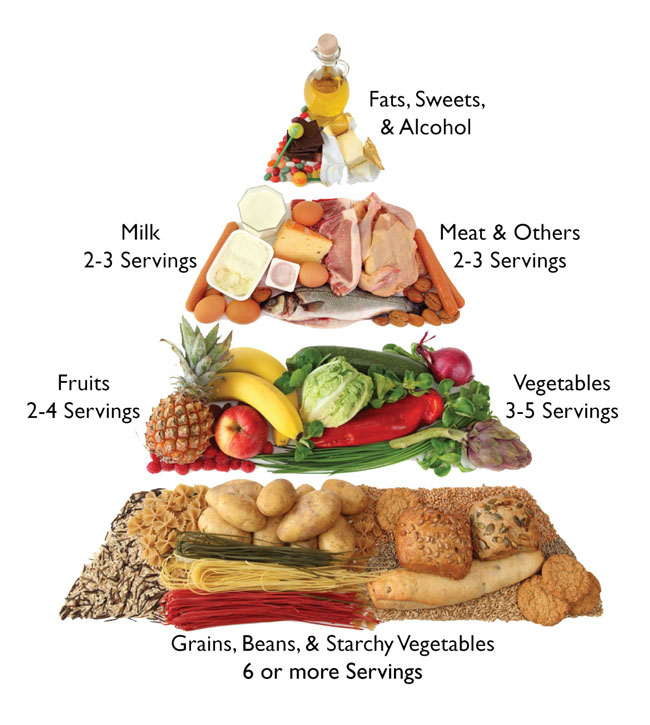
A calorie/kilojoule is a measure of the amount of potential energy contained in food. [Kilojoule (kJ) is the metric unit which replaces Calorie (kcal) and 4.184 kJ = 1 kcal]. The parts of your diet that your body can derive energy from are protein (4 kcal/17kJ), fat (9 kcal/37kJ), carbohydrate (4 kcal/17kJ) and alcohol (7 kcal/29kL) per gram. All have other functions in the body, except alcohol. Carbohydrate is the most efficient source of energy and protein is the least. These nutrients are found throughout the food groups and following the guidelines for Canada’s Food Guide will ensure the correct proportion of each will be available to your body.
It is recommended that of your total food intake approximately:
- 20% of the calories should come from protein,
- less than 30% from fat and
- 50-55% from carbohydrate.
For example, if Judy consumes about 2200 Calories per day:
440 Calories (20% of 2200) should be from protein, less than 600 Calories (30% of 2200) from fat and 1100 - 1210 Calories (50-55% of 2200) from carbohydrate. This translates to 110g of protein, less than 66g of fat and 275 - 302g of carbohydrate.
Jake calculated that in his diet he had 150g protein, 117g of fat and 300g carbohydrate. Do Jake’s figures fit the recommendations above?
|
|
grams |
Convert g to kcal |
Calories |
Total Calories |
Jake’s % of total |
Recommendations |
|
protein |
150 |
x 4 |
600 |
|
25 |
20 |
|
fat |
117 |
x 9 |
1050 |
3000 |
35 |
>30 |
|
carbohydrate |
300 |
x 4 |
1200 |
|
40 |
50-55 |
No. Jake should eat less protein and fat and more carbohydrate. To help Jake meet the recommendations you would do a 3 day food record to determine his selection of food groups. Probably he would need to select more Vegetables, Fruits and Grain Products (carbohydrate) and less Meat, Alternates and Milk Products (fat and protein).
APPROXIMATE DAILY RECOMMENDED CALORIE INTAKE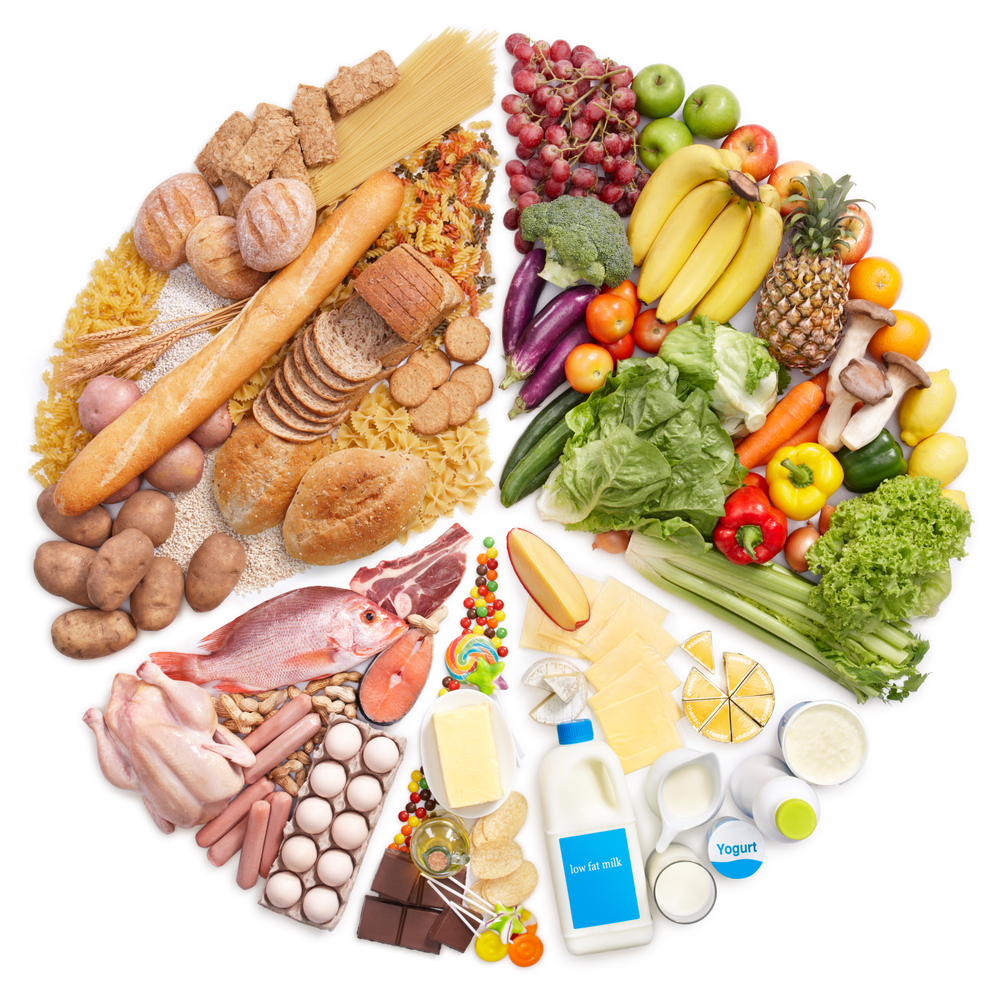
|
AGE |
GENDER |
RECOMMENDED NUMBER OF CALORIES FOR NORMAL ACTIVITY |
|
11 - 12 years |
MALE FEMALE |
2800 2400 |
|
13 - 15 years |
MALE FEMALE |
2800 2200 |
|
16 - 18 years |
MALE |
3200 |
|
|
FEMALE |
2100 |
|
19 - 35 years |
MALE |
3000 |
|
|
FEMALE |
2100 |
|
36-50 years |
MALE |
2700 |
|
|
FEMALE |
1900 |
FUNCTIONS OF MAIN NUTRIENTS
|
Nutrient |
Milk Products |
Grain Products |
Vegetables & Fruits |
Meat & Alternates
|
Function |
|
Carbohydrate |
|
√ |
√ |
|
|
|
Fat |
√ |
|
|
√ |
|
|
Protein |
√ |
√ |
|
√ |
|
|
Vitamin A |
√ |
|
√ |
√ |
|
|
Thiamine |
|
√ |
√ |
√ |
|
|
Riboflavin |
√ |
√ |
|
√ |
|
|
Niacin |
|
√ |
|
√ |
|
|
Folic Acid |
|
|
√ |
√ |
|
|
Vitamin B12 |
√ |
|
|
√ |
|
|
Vitamin C |
|
|
√ |
|
|
|
Vitamin D |
√ |
|
|
|
|
|
Calcium |
√ |
|
|
|
|
|
Iron |
|
√ |
√ |
√ |
|
|
Fibre |
|
√ |
√ |
|
|
Active living
ENERGY OUTPUT
There are two components to your energy requirements: Basal metabolic rate (BMR) which takes care of energy required for body processes at rest and physical activity. Your energy needs vary with your age, body size, BMR, physical activity and gender. Excess or unused energy (Calories) can be stored as body fat.
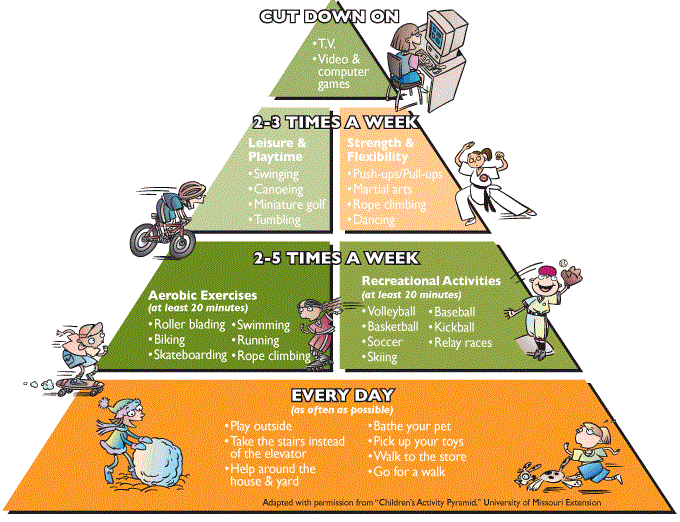
Total Energy Requirement = BMR (kcal/kJ) + physical activity (kcal/kJ)
Physical Activity is an important part of your lifestyle. Regular activity can:
- help control your weight
- reduce your body fat
- firm up your muscles
- improve your digestion
- improve your circulation and give you a healthier heart
- provide an opportunity to meet people
- regulate your appetite
- provide a release for emotional stress
Two Types of Energy Systems: Aerobic and Anaerobic
During physical activity your body relies on one or both of its energy systems. Aerobic activity refers to progressive, regular (low intensity) muscularactivity carried out over an extended period of time. It usually involves a large portion of the body. During this period of time the muscles rely on the presence of oxygen from respiration (breathing) to run the energy system. Examples of aerobic activities are walking, hiking, jogging, cycling, rowing, swimming,and cross country skiing
Anaerobic activity is very intense muscular activity (sprinting, lifting heavy objects). The energy demands of the muscles are greater than can be met by respiration alone. Under these circumstances, the muscles obtain the extra energy they need from anaerobic processes and incur an oxygen debt and an accumulation of lactic acid (in the muscles and liver). When the intense activity is over, you continue to breath hard for some time and continue to supply the liver with large quantities of oxygen to reconvert the lactic acid into muscle glycogen (a storage form of energy).
During participation in many different sports your body uses a combination of the two energy systems (aerobic and anaerobic), i.e. soccer, tennis, basketball: where the intensity of the activity alternates between high and low.
Extra Energy Needs
The need for energy from food increases in proportion to the increased energy expenditure. The size and weight of the individual, the type of activity and the frequency, intensity and duration of the activity are the major factors in determining the extra energy needs.
Sports requiring a single effort, like diving or golf, require high energy expenditure only if carried out intensively for long periods.
Sports such as soccer, marathon running and swimming which involve endurance, high intensity and hours of training require high energy expenditure.
USING PHYSICAL ACTIVITY TO CONTROL OR ALTER YOUR WEIGHT
An increase in physical activity can help you change your energy balance and help you lose body fat. If you wish to gain weight, regular, but not excessive exercise is still necessary as it will help you maintain a normal appetite and ensure that the weight gain is muscle tissue, not just fat.
The following variables in physical activity are related to the number of calories burned:
- Duration - the length of time and distance traveled
- Intensity - percentage of maximum heart rate
The number of calories burned is more closely related to an activity’s duration than to its intensity. For example, a one hour light walk burns more calories than a 20 min brisk walk. Also the Calories burned during a 2 km walk and 2 km run are identical because the distance traveled is the same.
Prolonged activity at low to moderate intensity (65% of maximum heart rate) is preferable to the same amount of work at higher intensity. Increase duration gradually, before you increase intensity. This is an effective method of burning calories when the goal is weight loss or weight control
Approximate Energy costs of Various Activities
|
ACTIVITY |
CALORIES/MIN |
KILOJOULES/MIN |
|
cycling, fast |
11.1 |
46.2 |
|
cycling, slow |
4.5 |
18.9 |
|
Dancing |
5.0 |
21.0 |
|
Gardening |
5.5 |
23.1 |
|
grocery shopping |
3.5 |
14.7 |
|
house cleaning |
2.0 |
8.4 |
|
Laundry |
3.0 |
12.6 |
|
rowing, 51 strokes per minute |
4.1 |
17.2 |
|
rowing, 87 strokes per minute |
7.0 |
29.4 |
|
rowing, 97 stokes per minute |
11.2 |
47.0 |
|
Sitting |
0.3 |
1.1 |
|
skiing, cross country |
20.0 |
84.0 |
|
skiing, downhill |
12.0 |
50.4 |
|
snow shoveling |
7.0 |
29.4 |
|
Standing |
0.4 |
1.4 |
|
Sweeping |
1.7 |
6.9 |
|
Swimming |
11.0 |
46.2 |
|
walking, brisk |
6.0 |
25.2 |
|
walking, light |
3.0 |
1 |
Janice has started walking 20 minutes a day to increase her physical activity and lose weight. Should she first try to walk faster for 20 minutes or walk 30 minutes a day at the same speed? Answer: 30 mins a day, then faster
Julie cycles after school every day for about 30 mins. She was losing weight up until a week ago but has now stabilized. To continue to increase her physical activity without increasing the time spent cycling what should she do? Answer: Cycle faster, for 30 mins
THE CAR ANALOGY
Three guys are driving to Banff. One is driving a mid sized car, a Chevrolet, the second is driving a small car - a Toyota Tercel and the third is driving a full sized model, a Lincoln.
1. What do the cars use for energy to get there? ____________
2. Which car will use the most energy? ____________
Why?
The Smith’s own a Jeep Cherokee. Mrs. Smith drives the jeep to work (10 km), Jeremy Smith drives to his friend’s house (2 km) and Mr. Smith drives the jeep on road trips (300 km).
3. For which trip will the Jeep require the most energy? ____________
Why?
Diane, Jennifer and Susan are all 17 years old. Diane is small framed, Sue is medium framed and Linda is full framed. They all have a similar daily schedule.
4. Where do these girls get their energy? ___________
5. Which girl will use the most energy in a day? ___________
Why?
Jim, Brad and Arthur are all 24 years old. Jim is a professional hockey player, Brad is a stay-at-home dad with 2 small children and Arthur is a computer operator who spends most of his day working at his computer.
6. Where do these guys get their energy? ___________
7. Which guy uses the most energy? _________
Why?
8. What are the two major factors (from above) that determine the amount of energy we
need from food?
Other factors that influence energy needs are: gender, age and BMR (basal metabolic rate).
Now try these:
|
|
|
Who needs more energy? |
What factors? |
|
8. |
Jane is 12. Her sister is 20.
|
|
|
|
9. |
Sandy likes to read and watch T.V and Alice enjoys swimming and dancing.
|
|
|
|
10. |
Emma and Robert are twins.
|
|
|
|
11. |
Mary and Lori are both 18 and play on the same soccer team. Mary weighs 135 lbs and Lori weighs 115 lbs. |
|
|
|
12. |
Jared and Connor are both 12 years old. Jared plays hockey and Connor loves video games.
|
|
|
Energy Balance
BODY ENERGY BALANCE (Weight Control)
Obesity ( more than 30% overfat) is a major problem in Canada and is associated with health problems such as diabetes and heart disease. On the other hand, many Canadians are too concerned about their body size and have nutritionally inadequate diets in order to conform to society’s body image.
Weight control is a balance of energy intake from food and energy output from your BMR (basal metabolic rate) and physical activity. When your intake equals your output, body weight remains constant (energy balance equation).
As your body weight changes so may your body composition and vice versa. Body composition will change in terms of amount of fat and muscle tissue. The amount of physical activity you do, in combination with altered food intake will influence your body composition. Your age, frame size and gender also influence your body composition.
Energy Balance
First some information:
- l lb of fat = 3500 calories
- For long term weight change the recommendation is 1- 2 lbs (0.5- 1 kg) per week (or a difference of 500 - 1000 Calories (14644 - 29288 kJ) /day).
- For weight reduction: physical activity and/or caloric intake for a combined effect of the deficit in Calories (kilojoules).
|
|
Eat
|
Use |
Effect on Body Weight |
|
1. |
2500 calories
|
2500 calories |
Your body weight stays the same |
|
2. |
2500 calories
|
2000 calories |
You have 500 calories which your body will store. Over 1 week you store 3500 calories which equals 1 lb of fat. |
|
3. |
2000 calories
|
2500 calories |
You lose weight. Over 1 week you would create a deficit of 3500 calories and lose 1 lb of fat. |
Preparing suitable foods
Now is your chance to apply what you have learned about the relationships between body image, wellness, healthy eating and active living.
1. Prepare a homemade snack and compare the nutritional values to a comparable commercial snack; e.g., granola, granola bar, cookies, muffins or beverage.
2. Plan, prepare and evaluate a healthy balanced meal to assist with the achievement of growth and development during teen years.
3. Plan, prepare and evaluate a healthy balanced meal to assist with the achievement of a healthy body weight.